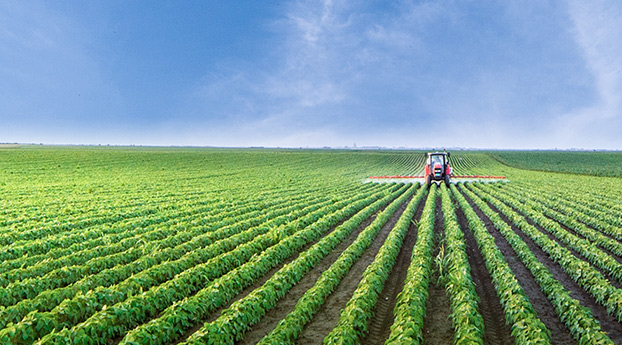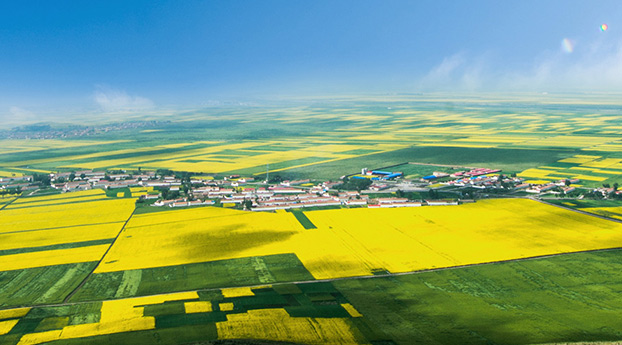Transpiration rules of jujube trees and water-saving regulation strategies in semi-arid region of Loess Hill
Release time:2015-01-16 Views:81
【作者】 魏新光;
【导师】 汪有科;
【作者基本信息】 西北农林科技大学 , 农业水土工程, 2015, 博士
【摘要】 红枣(Ziziphus jujube Mill.)是陕北地区的传统树种,自1999年国家退耕还林政策实施以来种植规模逐渐扩大,干旱缺水一直是制约当地红枣产业持续健康发展的瓶颈。由于长期粗放的种植经营方式和林地土壤水分的过度消耗,导致了当地生态环境的退化甚至永久性土壤水分干层的出现。枣林地的蒸腾耗水受到气象因子、土壤水分状况、立地条件以及自身生长发育状况的综合影响,变化复杂。掌握枣树蒸腾规律进而对其耗水过程进行有效的调控,对于实现林地土壤水分的动态平衡和生态经济林(枣林)的可持续经营均具有重要的意义。本文以陕北榆林地区广泛种植的梨枣(pear-jujube)为研究对象。采用TDP树干液流监测系统、CNC100中子水分仪、TDT土壤水分监测探针、自动气象站以及冠层分析仪等观测设备对枣林的蒸腾动态、深层土壤水分状况(0~10m)、气象因子、树体生长发育指标等进行连续三年的定位观测,对枣树和枣林地的耗水及其变异规律、各影响因子对其响应方式及其节水调控策略进行了深入分析,得到如下研究成果:(1)树体液流日内变化总体呈现单峰变化趋势,但其启动时间、峰值大小、旺盛蒸腾时长、开始减弱和基本停滞的时间会随着生育期的改变以及其他影响因子的变化而发生变化。枣树蒸腾在生育期始末的5和10月较低,而在生育中期的6~9月较高(80~105mm/月)。枣树生育期的蒸腾主要发生在白天,但是夜间也存在液流现象,枣树夜间液流占全天蒸腾的10\%~25\%左右。引起夜间液流现象的主要原因是树体的根压吸水作用。在枣树生育期和休眠期其液流测定参数的变化规律存在显著差异,基于这一特征可以对枣树的生育期进行较为准确的界定。通过对比发现,基于液流特征确定的生育期和观察树体萌芽落叶确定的生育期时长基本一致,都约为160天左右。但基于液流特征确定的生育期日期会提前5天左右。枣树树体液流的启动要早于树体的萌芽,而树体的落叶发生在液流基本停止以后。树体的液流在生育初期启动以后要经历约1个月左右的增强过程,而树体液流的减弱到基本停止仅需要2~3天。(2)枣树的蒸腾和其生长发育指标之间关系密切,树体的边材面积和瞬时蒸腾(液流速率)成反比,而和日蒸腾量呈正比,枣树全生育期叶面积和叶面积指数均呈二次曲线变化,当叶面积较小时(LA<2.1m2),叶面积和蒸腾之间存现显著的正相关关系(R2=0.84)。不同树龄枣树的耗水规律基本相同,在生育初期,不同树龄间耗水差异不显著,而生育中后期随着树龄的增加,耗水会显著增强。日蒸腾的最大值一般出现在7~9月份。不同树龄枣树蒸腾的变异与波动在年际存在差异,2012和2014年,不同树龄的生育期蒸腾的变异系数在生育始末期变异较小,中期差异很大(C.V值40\%~60\%),符合二次曲线变化规律(R22012=0.6061,R22014=0.3196)。2013年的变异系数在初期和后期都比较小,符合3次曲线变化(R22013=0.3483),这可能和当年生育后期降雨频繁,辐射强度偏低有关。(3)枣树蒸腾和气象因子的关系比较显著,而且逐日蒸腾、逐月蒸腾和全生育期蒸腾的主要影响因子不同,相同影响因子的响应程度(R2)和响应方式(K)也会随着时间的改变而发生变化。总体而言VPD和PAR是影响蒸腾的两个主要因子,同时也是枣树蒸腾两个主要的驱动因子。通过对液流上升、下降阶段和两大驱动因子的关系重点分析,发现两因子和液流均呈现极显著的正相关关系,而且液流和PAR的相关性比VPD更高。枣树的日蒸腾和两因子也呈极显著相关,但是相关系数会随着研究时间尺度的提高而降低,生育期各月液流和两因子均呈极显著相关,且液流对PAR的响应程度均高于VPD。(4)枣树对两大蒸腾驱动因子的响应存在明显的“时滞效应”。在蒸腾的启动阶段,两因子和蒸腾几乎同时启动。达到峰值的时间蒸腾最早、PAR次之、VPD最后。而液流的下降过程,PAR最早、蒸腾次之、VPD最后。由于“时滞效应”的存在,枣树对PAR和VPD的响应会存在阈值现象,在液流上升阶段当两因子超过一定阈值时候,蒸腾开始保持基本稳定而不再增加。反之在液流下降阶段当两因子降低到阈值以下,液流才开始显著降低。VPD的阈值在上升下降阶段均稳定在3.5Kpa左右,而PAR的阈值在上升和下降阶段存在差异(1000μmolm-2 s-1~1200μmolm-2 s-1)。这种时滞现象的存在也是枣树抗旱特征的重要标志,可以有效避免了枣树的过分失水。但两因子的响应阈值也会随着环境温度等影响因素的改变而发生改变(5)运用中子仪和土壤水分探针两种方法监测的枣林地1m层土壤水分变化规律完全一致,但是当土壤水分较低时,TDT探针监测的土壤含水量数据偏低。枣林地土壤水分受降雨影响波动剧烈。在丰水年(2013年)显著上升(1m层土壤储水量+28mm),平水年(2012年)略有亏缺(-5.5mm),在枯水年(2014年)亏缺严重(-40mm)。土壤含水量的波动和变异程度(C.V)随着土层深度的加深逐渐降低,枣林地土壤自上而下按照其水分变化情况和波动程度可划分为:土壤水分剧烈变化层(0-0.6m),土壤水分变化层(0.6-2.6m),土壤水分干层(2.6-6m)和土壤水分恢复层(6-10m)。在不同水文年型,枣树的蒸腾量均会随着土壤含水量的上升而增加。土壤水分状况不仅能引起日蒸腾量的变化,也会引起瞬时蒸腾(液流)特征的改变。随着土壤含水量的上升,液流谷值出现的时间提前,峰值出现时间推后,液流“午休”时间缩短,保持旺盛蒸腾时间延长,反之亦然。(6)通过在不同时间尺度上对影响枣树蒸腾的气象因子、土壤水分和生长因子的的综合分析,发现各因子和蒸腾相关性(R2)均在生育期较高。生育期逐月蒸腾在时尺度的主导因子为PAR(R2max=0.68)、日尺度上为RH(R2max=0.78)和WS(R2max=0.81)、旬尺度为LAI(R2max=0.82)和LA(R2max=0.73)。全年蒸腾量在较小时间尺度上(时和日尺度)和气象因子均呈极显著相关(p<0.01),而在较大尺度(旬和月尺度)上仅和LAI、LA和SW呈极显著相关(p<0.01)。土壤水分和枣树全年蒸腾总量极显著相关,但是逐月蒸腾关系并不显著,即枣树全年蒸腾总量主要受土壤水分状况影响,逐月蒸腾主要与自身生长发育阶段有关。随着尺度的提升,气象因子对蒸腾的相关关系逐渐减弱,作物自身生长状况和蒸腾的相关关系逐渐增强。但是相同时间尺度上逐月蒸腾量和全年蒸腾量的主要影响因子存在差异。(7)为了探求通过修剪控制枣树蒸腾和林地水分消耗的有效方法,通过修剪对枣树树体规模进行梯度控制。发现修剪可以显著的降低树体的蒸腾耗水。修剪造成的蒸腾耗水的差异:白天>夜间,晴天>阴天。在不同生育阶段,修剪造成蒸腾耗水的差异在萌芽展叶期差异不显著,而在开花座果、果实膨大、成熟落叶期以及全生育期均差异显著。经过连续2年的修剪控制,重度修剪比不修剪对照(CK)蒸腾量减小了68.6\%,土壤含水量增加40.5mm。由此可见,通过修剪减少树体规模可以显著的减少土壤水分消耗,增加土壤储水量。构建了山地枣林产量和需水量的水分生产函数方程,确定了山地枣林理论最大产量为16181.2 kg/hm2。此时水分生产效率仅为17.46 Kg/hm2/mm。随着枣树产量的增加,会带来水分生产效率的大幅下降。以当地多年平均降雨量450.1mm为供水量上限。根据水分生产函数方程,确定了可实现山地枣林可持续经营的枣林地产量目标:亩产800公斤,此时的水分生产效率上升到26.25Kg/hm2/mm,初步实现了“以水定产”。并通过线性和非线性的评价方法对产量和树体规格因子的关系分别进行了综合评价,结合生产实际确定出了冠幅体积和新稍长度两个“节水型修剪”的调控指标,为以产定型(树体规格)奠定了基础。
【Abstract】 Chinese jujube(Ziziphus jujube Mill.) is native tree species in Northern Shaanxi Province. The area of cultivation has been continuously expanding since China implemented the policy of "Conversion of cropland to forestland" in 1999, drought and water shortage have been the bottleneck of restricting the sustainable and healthy development of the local jujube industry. The planting mode of long-term extensive and the excessive consumption of soil moisture in forests, leading to the deterioration of ecological environment and the appearance of permanent soil moisture dry layer. Water consumption of jujube orchard changes complexly, influenced comprehensively by meteorological factors, soil water status, site conditions and its growth and development of their own situation. To grasp the regulation of jujube transpiration and regulate its water consumption process effectively, it is significantly important to realize the dynamic balance of soil moisture in( jujube) forest and the sustainable management ecological economic forest(jujube forest).In this paper,pear jujube widely cultivated in Yulin of Northern Shanxi Province, was the studying object. Used the equipments of TDP(Thermal Diffuse Probe) sap flow monitoring system, CNC100 neutron moisture meter, TDT(Time Domain Transmission) soil moisture monitoring probe and leaf area index instrument to observe jujube dynamic transpiration, deep soil moisture condition(0-10m), meteorological factors, tree growth indexes consecutively for three years. Water consumption and its variation of jujube and jujube forest, the response of them to the influencing factors were analyzed, and water saving regulation strategy was put forward. Research results are as follows:(1)The variation of jujube’s sap flow during the day presented unimodal trend overall. The start time, the magnitude of the peak, the time of exuberant transpiration, the time began to recede and the time stagnated basically changed with the growth period and other factors. Jujube transpiration was low at the beginning and the end of the growth period in May and October, respectively. while was high(80~105mm) from June to September. Transpiration of jujube in the growth period occurred mainly during the daytime, but the sap flow phenomena also existed at night, jujube night transpiration accounted for about 10\%-25\% of the daily transpiration. A major cause of night transpiration phenomenon was root pressure absorption in trunks. Significant differences were found in the change regularity of sap flow measurement parameters during the jujube growth period and dormant period. Based on this feature, the growth period of jujube could be demarcated more accurately. Found by comparing, the length of growth period based on sap flow characteristics was the same as determined by the observation of sprout and defoliation, both are about 160 days. But the date of growth period based on the sap flow characteristics would be about 5 days in advance. Sap flow of jujube trees started earlier than sprout, and defoliation started after sap flow basically stopped. After the sap flow in early growth stage of jujube trees started, it would experience gradually enhanced process, about 22-34 days. And 2-3 days after the liquid flow stopped, defoliation would occur on a large scale. And the complete recession of sap flow only need 2-3 days.(2) The transpiration of jujube was closely related to its growth and development indexes. Sapwood area of jujube tree was inversely proportional to the instantaneous transpiration(sap flow rate), but proportional to the daily transpiration. Leaf area(LA) and leaf area index(LAI) of jujube in the whole growth period both changed as quadratic curve, while the LA was small(LA < 2.1m2), it was significant proportional to the transpiration(R2=0.84). The law of water consumption of jujube of different ages was basically the same, in the early growth stage, jujube of different ages did not show significant difference in water consumption. With the increase of age in the late growth stage, water consumption would significantly increase. The maximum of daily transpiration usually appeared from July to September, the change law of different aged jujube were significant different. The transpiration variable coefficient(R2) of different tree-age changed in accordance with quadratic curve in 2012 and 2014(R22012=0.6061, R22013=0.3196), differences were small at the beginning and the end of the growth period but large in the middle of the growth period(C.V = 40\%- 60\%). In 2013, the variation of evapotranspiration among trees with different ages were quite small both in early and later growth period, consistent with the cubic curve(R22013=0.3483), it might be caused by the frequent rainfall and low radiation intensity at the end of the growth period.(3) The relationship between jujube transpiration and meteorological factors was significant, the main effect of daily transpiration, monthly transpiration and transpiration of the whole growth period were different, response degree(R2) and mode(K) of the same impact factor vary with time. VPD and PAR overall are two main impact factors of transpiration, which are also two main driving factors of jujube transpiration. Analyzed the relationship between sap flow varying and two main driving factors, found that there were highly significant correlations between both two main factors and sap flow, and the correlation between sap flow and PAR is higher than that between sap flow and VPD. The daily transpiration of jujube showed significant correlation with two factors, while the correlation coefficient decreased with the expansion of time scale. The monthly transpiration in the growth period also showed significant correlation with two factors, and the response of sap flow to PAR is more significant than that to VPD.4) The response of jujube to two transpiration driving factors showed "time lag " obviously. At the start stage of sapflow, two factors and transpiration started almost at the same time, the peak time of transpiration was earliest, PAR was the second, and VPD was the last. In the decline process of sap flow, PAR change first, transpiration was the second, and VPD was the last. Threshold phenomena existed in the response of jujube to PAR and VPD. In the sap flow rising stage, transpiration would maintain its value stability and no longer increase when two factors beyond a certain threshold. Whereas in the sap flow decline stage, sap flow would decrease significantly until two factors decreased below the threshold. The thresholds of VPD were stable at around 3.5Kpa during the whole stage, while the thresholds of PAR were different at the increase and decrease stage(1000μmolm-2 s-1~1200μmolm-2 s-1). This kind of lag phenomenon was the important sign of jujube drought resistance characteristics, which avoided excessive water loss of jujube effectively. The threshold responded of two factors changed with affect factors such as temperature in environment.5) The change laws of soil moisture in depth 0-1m of jujube forest monitored by neutron moisture gauges and soil moisture probe were completely consistent. The value of soil moisture monitored by TDT probe was lower than the fact when the soil moisture is low. Jujube forest soil moisture fluctuated fiercely due to the rainfall, it increased significantly(soil water storage +28mm) in a wet year(2013), waned a little(-5.5mm) in a slight year(2012), and waned a lot(-40mm) in a dry year(2014). The fluctuation of soil moisture slowed down with the increase of the soil depth(0~10m depths). From top to bottom it could be divided into soil moisture variation layer(0~2.6m), soil moisture dry layer(2.6~6m), and soil moisture recover layer(6~10m). In different rainfall years, transpiration of jujube would increase with the rise of soil water content. Soil moisture condition could not only affect the daily transpiration, but also could affect the instantaneous transpiration(sap flow). The increase of soil moisture would make the minimum value of the sap flow appeared ahead of time, the appearance of the maximum value of the liquid flow delayed, and shorten the time of “lunch break”, and vice versa.(6) The comprehensive analysis of meteorological factors, soil moisture and growth factor on different time scales affecting jujube transpiration, found that the correlations(R2) between factors and transpiration all high in the growth period. The dominant factors of monthly transpiration in the growth period were PAR(R2max=0.68) on hours scales, RH(R2max=0.78) and WS(R2max=0.81) on days scales, and LAI(R2max=0.82) and LA(R2max=0.73) on ten day scales. On small time scales(hours and days scale), the annual transpiration was significantly correlated with climatic factors(p<0.01); while on large time scales(ten days and monthly scale), the annual transpiration was only significantly correlated with LAI, LA and SW(p<0.01). Soil moisture was in significant correlation with jujube annual transpiration, but not correlation with monthly transpiration. That is to say, annual transpiration was mainly affected by the soil moisture status, monthly transpiration was mainly affected by its own the growth and development stage. With the scale of time enlarging, the correlation between meteorological factors and transpiration gradually lowered, and the correlation between crop growth status and transpiration gradually heightened. Main affect factors of monthly transpiration and annual transpiration were different on the scales of the same time.7) In order to explore the effective methods of pruning to limit the jujube transpiration and water consumption of forest land, controlled the gradient of jujube tree body size by pruning. Found that pruning can reduce the transpiration of tree water consumption significantly. Differences in transpiration caused by pruning: daytime > nighttime, sunny day > cloudy day. In the growth period, transpiration and water consumption caused by pruning were not significant different in the germination stage, while in the stage of blossom, fruit setting, fruit enlargement, maturity and leaf fall stage, the differences of transpiration and water consumption were all significant different. After taking pruning control of two years consecutively, the transpiration of severe pruning decreased by 68.6\% compared with that without pruning(CK), and the soil moisture increased by 40.5mm. Thus, reducing the tree size by pruning could reduce soil water consumption and increase soil water storage significantly. Rain-fed jujube production and water consumption equation could be constructed, and it determined the maximum of mountain jujube production is 16181.2 kg/hm2 theoretically, while the water use efficiency was only 17.46 Kg/hm2/mm at this time. With the increase of the production of jujube tree, water use efficiency would decrease sharply. With the water supply upper limit of years average rainfall 450 mm, and calculated by the equation of production and water consumption, jujube forest production target of sustainable management could be realized and identified: about 800 kg per mu, water use efficiency would increase to 26.25 kg/hm2/mm. The “water decide production” could be implemented preliminarily, and the relationship between production and tree specification factor could be evaluated comprehensively by the evaluation of linear and nonlinear methods, combined with the actual production, determined that of crown volume and new slightly length were the "water-saving pruning" indexes to regulate and control, which would lay the foundation for size(tree specification) decided by production.
【关键词】 蒸腾; 土壤水分; 气象因子; 节水调控; 黄土高原;
【Key words】 transpiration; soil moisture; meteorological factors; water management; Loess Plateau;

















